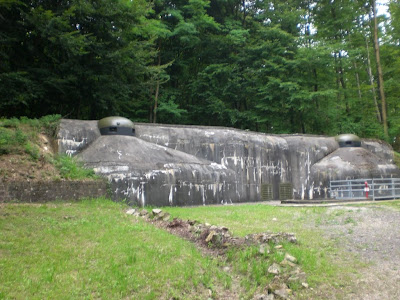 First, some background. After World War I France was leery of being invaded again and between 1930 and 1940 built a formidable defense system along its borders with Germany and Italy. This vast fortified network was made up of 44 large artillery forts, 62 medium size infantry forts, 365 casemates, 17 observation posts, 89 midway shelters, over 159 turrents of all kinds and several thousand blockhouses. This architect of this massive defensive plan was France's Minister for War Andre Maginot--hence the name Maginot Line. The French were so proud of this seemingly impregnable line that I think that's when they started walking around with their chests puffed out. When World War II broke out and Germany invaded France this supposedly impregnable line was made worthless. How? Two things. One, the Germans did an end around by invading neighboring Belgium (thus bypassing the line) and two, the German Luftwaffe (air force) simply flew over the Maginot Line.
First, some background. After World War I France was leery of being invaded again and between 1930 and 1940 built a formidable defense system along its borders with Germany and Italy. This vast fortified network was made up of 44 large artillery forts, 62 medium size infantry forts, 365 casemates, 17 observation posts, 89 midway shelters, over 159 turrents of all kinds and several thousand blockhouses. This architect of this massive defensive plan was France's Minister for War Andre Maginot--hence the name Maginot Line. The French were so proud of this seemingly impregnable line that I think that's when they started walking around with their chests puffed out. When World War II broke out and Germany invaded France this supposedly impregnable line was made worthless. How? Two things. One, the Germans did an end around by invading neighboring Belgium (thus bypassing the line) and two, the German Luftwaffe (air force) simply flew over the Maginot Line.Located in the midst of a heavily-wooded forest you could pass right by Fort Schoenenbourg without having a clue as to its location and size. This is the largest Maginot fort open to the public AND (the best part) you are not restricted to guided tours! It was built to house a garrison of 630 men who could resist attack for several months without receiving supplies.
 This electrified narrow-gauge train was used to transport supplies and ammunition through the long, long corridors.
This electrified narrow-gauge train was used to transport supplies and ammunition through the long, long corridors. You go through this entry and take stairs down, down and down to begin the tour---almost 100 feet underground! It's 90 degrees outside but down below it's cold, very cold. Thankfully I was prepared and brought a jacket.
You go through this entry and take stairs down, down and down to begin the tour---almost 100 feet underground! It's 90 degrees outside but down below it's cold, very cold. Thankfully I was prepared and brought a jacket. The self-guided tour takes about two hours and you end up walking something like four miles. Reaching the farthest point it then took 25 minutes of fast power walking to return to the beginning.
The self-guided tour takes about two hours and you end up walking something like four miles. Reaching the farthest point it then took 25 minutes of fast power walking to return to the beginning. Clearly marked arrows show you which way to go through the maze of tunnels and closed-circuit cameras are set up throughout the underground complex so visitors don't get lost.
Clearly marked arrows show you which way to go through the maze of tunnels and closed-circuit cameras are set up throughout the underground complex so visitors don't get lost. Remember about five blogs ago when I visited Fort Mutzig, the underground fortress built by the Germans back in 1890? Any immediately noticeable differences beween the two? If you recall poison gas was used in World War I. Here, the air pumped in gets put through a double filtration system to foil any poison gas penetration.
 Above ground nothing is visible except fortified observation posts and huge gun turrents. What you don't see are the massive platforms below ground which the guns are mounted on. This photo (below) shows part of a three-story cannon platform.
Above ground nothing is visible except fortified observation posts and huge gun turrents. What you don't see are the massive platforms below ground which the guns are mounted on. This photo (below) shows part of a three-story cannon platform.

Of course the place has its own gigantic power generators, water tanks, full on hospital, kitchens even a chapel.
 Above ground nothing is visible except fortified observation posts and huge gun turrents. What you don't see are the massive platforms below ground which the guns are mounted on. This photo (below) shows part of a three-story cannon platform.
Above ground nothing is visible except fortified observation posts and huge gun turrents. What you don't see are the massive platforms below ground which the guns are mounted on. This photo (below) shows part of a three-story cannon platform.
Of course the place has its own gigantic power generators, water tanks, full on hospital, kitchens even a chapel.







Paul,
ReplyDeleteI wish that I were teaching history again as I would use these slides. Had no idea of the sophistication of this underground, self-contained bastion. Do we have any journals of these 640 men? How long did they stay? Would it be a rotation system? Thanks for the information.
Intriguing, but unfortunately it didn't stop the Blitzkreig. I need teo go visit. Thanks for the blog
ReplyDelete